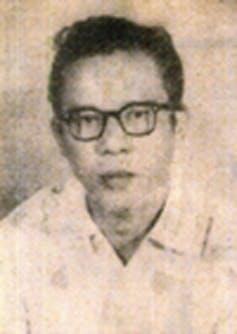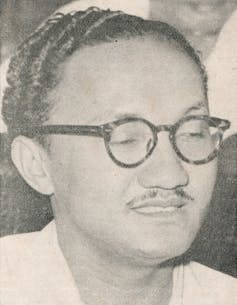This month marks the 50th anniversary of the start of Indonesia’s anti-communist purge that killed nearly a million people between 1965 and 1966.
The pogrom not only destroyed human lives but also cultural artefacts made by the country’s left-inspired artists. Cinema reels in particular were obliterated more completely than other art forms such as literature or paintings. Wanton destruction and later wilful neglect and suppression completed the wipe-out of the fragile celluloid.
The coup and its consequences for Bactiar Siagian

Arguably the country’s most significant leftist film director and theorist, Bachtiar Siagian was among the millions who fell prey to the anti-communist purge. He was imprisoned without trial for 12 years, and was released from prison in December 1977.
Siagian was shooting a documentary at a conference in Tokyo when a coup attempt in the morning of October 1 1965 was crushed within hours by the senior leadership of the army. The botched coup became the pretext for General Suharto’s anti-communist crackdown and laid the foundations for Suharto’s long reign.
Several weeks after returning from Japan Siagian realised his life was in danger. He read in a newspaper article that authorities were offering a cash reward for his arrest. He went underground but was captured in early 1966.
A founding father of Indonesia’s cinema?
Siagian’s film career spanned 1955-65, the period of the most open conflict of ideology and interest, often simplistically presented as being between religion and communism. Cinema was caught up in this strife most directly through conflicts between the PKI-connected (Indonesian Communist Party) film workers’ organisation, SABUFIS, and the PPFI, an alliance of film producers.
In that decade Siagian wrote and directed 13 feature films. This made him one of the most prolific indigenous Indonesian directors of his time, in an industry dominated by overseas Chinese money and talent.
Histories of cinema written under Suharto’s New Order cast Siagian as the communist who politicised cinema, in contrast to Usmar Ismail, another indigenous filmmaker, who led the defence of cinema as an art form. Ismail was eventually anointed the “father of national cinema” by New Order-endorsed film archivists.

In reality, Ismail and Siagian, both born in Sumatra in the early 1920s, were in many ways each other’s foils.
Born into an aristocratic family, Ismail received a Dutch education that very few of his generation of native Indonesians could aspire to. Siagian was the son of a railway worker who grew up among children of plantation labourers. That he went to school at all was thanks to a Dutch woman for whom he worked as a domestic servant. He received no formal education beyond primary school.
Like many filmmakers of his generation, Siagian learned his craft during the Japanese occupation of 1942-45. In 1950, he joined LEKRA, the Indonesian Communist Party’s (PKI) cultural organ.
Experience of Japanese war propaganda convinced Siagian of the political power of cinema. He started reading and writing extensively about Russian cinema. By contrast, Ismail was enthralled by Hollywood, particularly after a study tour to the US in 1953.
Life after prison
When I first met him in 1981, “Pak Bachtiar” was nearly 60, living in dire poverty on the edge of Jakarta. He was not part of the network of former political prisoners that was emerging in Jakarta in the early 1980s. Nor, unlike many of his literary counterparts (most famously Pramoedya Ananta Toer and his publishers), did he acquire a following among students and young intellectuals who had come to adulthood since 1965 and were trying to make sense of their cultural heritage.
Siagian had never been good at toeing the line either personally or artistically. In his active years, he often fell out with the leadership of the PKI. His films fell afoul of the Censorship Board regardless of who was in charge in the constantly changing dynamics of 1955-65.
Siagian was transferred from prison to prison during his incarceration: first, Jakarta’s Salemba; then Nusakambangan, the island prison off the Java’s South Coast; finally Buru, the notorious penal colony in the Moluccas Islands. Yet his years of imprisonment had not dampened his charisma nor his conviction that a film could only ever be a vehicle for an ideology.
Banned from participating in media work after his release, he eked out a miserable living writing film scripts anonymously. This work dried up too after 1983, when new regulations by the Suharto government, under the euphemistic banner of “bersih lingkungan” (clean environment), further restricted former political prisoners and their families from work in education and the media industries.
Siagian died in 2002, entirely unnoticed by the media.
Progressive cinema?
We will probably never know Siagian’s films beyond what can be glimpsed in his annotated scripts. Neither contemporaneous reviews nor later attacks on Siagian have seriously argued that his films contained communist propaganda.
Siagian wrote his own film scripts, most of which have thankfully survived. Whether or not there was artistic merit in his films, his stories are clear: in them the socially weak and powerless, wong cilik (literally “small people”), in his Indonesia do great things against great odds.
His first film, Kabut Desember (December Mist) in 1955, remained until the 1980s the only Indonesian film that treated prostitutes as anything but abject. In 1961, the PKI leadership tried to stop the circulation of Baja Membara (Burning Steel) because of what they saw as its pro-Islam stance.
Violetta, created in 1962, is the only film of his that survived.
Bachtiar Siagian’s films were shown in festivals in the Soviet Union and other Eastern Bloc countries. Unless his other films remain to be found in the archives of those nations, Indonesia will always be left with a gaping hole in its film history.

